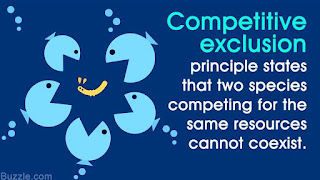In ecology, the principle of competitive exclusion, sometimes referred to as Gause law, is a proposition dubbed Georgy Gause that two species competing for the same limiting resource can not coexist in a constant population. values. When a species has the slightest advantage over another, its profit will dominate in the long run. This leads to the extinction of weaker competitors or evolutionary changes or behavior toward different ecological niches. The principle has been paraphrased in the maxim "Competitors can not live side by side".
Video Competitive exclusion principle
History
The principle of a classically competitive exception is attributed to Georgii Gause, although he never actually formulated it. The principle already exists in Darwin's theory of natural selection.
Throughout its history, the status of the principle has been tossed between a priori ('two species coexisted must have different niches') and experimental truth (' we find that species coexist do have a different niche ').
Maps Competitive exclusion principle
Experimental bases
Based on field observations, Joseph Grinnell formulated the principle of a competitive exception in 1904: "Two species from around the same dietary habits are unlikely to remain long equal in equal numbers in the same region, one will outperform the other." The Russian ecologist Georgy Gause formulates the law of competitive exceptions based on laboratory experimental experiments using two species of Paramecium , P. aurelia and P. caudatum . His condition is to add fresh water daily and include a constant stream of food. Although P. caudatum was initially dominated, P. aurelia recovered and then rode P. caudatum extinct through exploitative resource competition. However, Gause can let P. caudatum survive by distinguishing environmental parameters (food, water). Thus, Gause law only applies if its ecological factors are constant.
Gause also studied competition between two yeast species, found that Saccharomyces cerevisiae consistently competed against Schizosaccharomyces kefir by producing higher concentrations of ethyl alcohol.
Prediction
Competitive exclusion is predicted by mathematical and theoretical models such as the Lotka-Volterra competition model. However, for reasons that are poorly understood, competitive exceptions are rarely observed in natural ecosystems, and many biological communities seem to violate Gause law. The most famous example is the so-called "paradox of the plankton". All plankton species live with very limited resources, especially solar and mineral energy dissolved in the water. Under the principle of competitive exceptions, only a small number of plankton species can coexist with these resources. However, a large number of plankton species co-exist in small open sea areas.
Some communities that seem to uphold the principle of competitive exclusion are the MacArthur handlers and Darwinian kutilang, although the latter is still ecologically overlapping, only negatively affected by competition under extreme conditions.
Paradoxical characters
The partial solution to paradox lies in increasing the system dimension. Spatial heterogeneity, trophic interactions, multiple resource competitions, colonization-colonization, and lags can prevent exceptions (ignoring the stochastic extinction for longer periods). However, such systems tend to be analytically difficult. In addition, many can, in theory, support an unlimited number of species. New paradoxes are created: Most well-known models that allow stable coexistence allow an unlimited number of species to co-exist, but, in nature, each community contains only a handful of species.
Redefined
A recent study that discusses some of the assumptions made for models that predict competitive exceptions has shown these assumptions need to be reconsidered. For example, slight modification of assumptions about how growth and related body size leads to different conclusions, namely that, for a given ecosystem, certain species can coexist while others become less competitive.
One of the main ways to share niche species side by side is the trade-off colonization. In other words, a better competitor species will become a specialist, while better colonized species are more likely to be generalists. The host-parasite model is an effective way to test this relationship, using host transfer events. There seem to be two places where the ability to colonize differs ecologically closely related species. In flea lashes, Bush and Clayton provide some verification of this by showing two closely related genera with lice almost equally in their ability to colonize the new host pigeons after being moved. Harbison continues this line of thinking by investigating whether two genera differ in their ability to transfer. This study focuses primarily on determining how colonization occurs and why wing infestation is a better conqueror than body lice. Vertical transfer is the most common occurrence, between parent and offspring, and much learned and well understood. Horizontal transfer is difficult to measure, but in ticks it appears to occur through phoresis or "piggyback" one species in another. Harbison found that body lice were less proficient in the field of phoresis and excel competitively, while wing lice excel in colonization.
See also
- Limiting factor
- Restrict the similarities
- Paradox of plankton
References
Source of the article : Wikipedia

